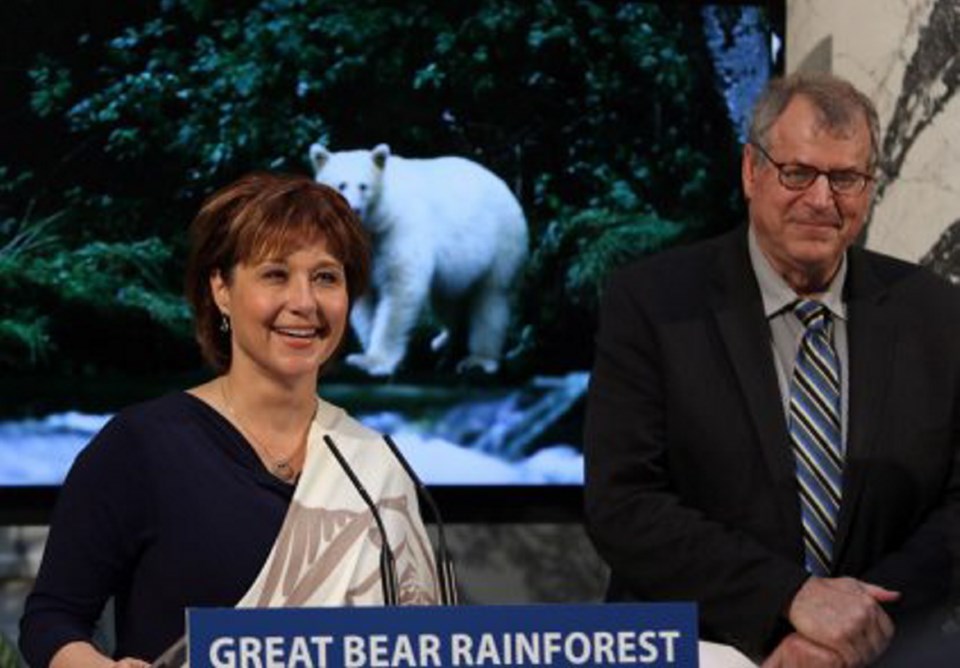 The Great Bear Rain Forest legislation introduced Tuesday takes the authority to set logging limits away from the chief forester and hands it to cabinet for the next 10 years.
The Great Bear Rain Forest legislation introduced Tuesday takes the authority to set logging limits away from the chief forester and hands it to cabinet for the next 10 years.
The chief forester is generally considered to have the independent authority to set the allowable annual cut on Crown land in timber-supply areas and the province as a whole. The allowable cut is the maximum amount of wood that can be harvested sustainably, based on numerous technical factors.
The Great Bear Rainforest (Forest Management) Act strips that authority and several other forest-management decisions from the chief forester and gives it to cabinet for a 10-year adjustment period.
It’s part of the certainty provisions that timber companies insisted on during the years of negotiations on the future of that wilderness. The bill, which uses the word “certainty” 14 times in 46 pages, legislates some aspects of the far-reaching deal signed a month ago that preserves most of the six million hectares of mid-coast rainforest.
Commercial logging is restricted to about 550,000 hectares, and must be done following strict new ecosystem-based management rules. Most of the bill relates to logging restrictions.
The deal agreed to last month allows for about 2.5 million cubic metres of timber harvest per year on the 15 per cent of the area that isn’t closed to logging.
Ric Slaco chairs a group representing logging companies in the region. He said following a news conference Tuesday that the change in the cut authority was part of the deal worked out over the past 10 years.
“What’s important to us is to know we have certainty.”
He said there could have been potential to see the deal start to erode over the years, so the certainty was important.
“The certainty to us is to say: It’s 2.5 million cubic metres.”
Slaco recalled that 20 years ago he was at the front lines of the War of the Woods, as chief forester for Interfor, which had holdings in Clayoquot Sound. He described the transformation that has happened over that time.
“It was a matter of realizing we were dealing with something special; initially people didn’t get that. They just saw it [the Great Bear] as part of B.C. that had a lot of trees on it, which was of interest to us, but also a lot of other groups.”
Once the industry got to the realization it was a globally significant area, it had to search for a solution.
Total preservation wasn’t the answer, he said, because the forest industry is hugely important to the coastal economy.
“But logging wasn’t going to be a solution, either,” he said.
When the long process of negotiating the future of the Great Bear Rainforest began, he said the annual allowable cut in the area was four million cubic metres.
Slaco said the whole transformation process was an bit of an experiment for the industry. Setting aside parks was one aspect, but developing ecosystem-based management, defining it and balancing it was another that took a lot of time. Slaco said environmental groups would urge companies to do something and they would respond by saying it was operationally impossible.
“If we tried to do what you wanted to do, we couldn’t do it; we wouldn’t be in business.”
There had to be a lot of compromising on questions like those, he said.
There is no value figure attached to the amount of timber harvest that is relinquished, he said, because it was to be balanced by what is gained.
“I don’t think just doing the strict math on the one without somehow accounting for the other would work.”
“What we’re getting for it is a dedicated land base, a defined amount of harvest, a harvest that is conflict-free, a harvest we can plan our business around. It comes with social licence.” It also has First Nations logging opportunities that are important.
“The significant part of this agreement for the forest industry is that we’re still going to cut trees down. We’re going to cut down less of them and cut them down in a different way ... We didn’t do this to go out of business.”



